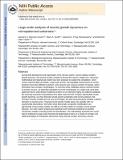| dc.contributor.author | Wissner-Gross, Zachary D. | |
| dc.contributor.author | Scott, Mark Andrew | |
| dc.contributor.author | Ku, David L. | |
| dc.contributor.author | Ramaswamy, Priya | |
| dc.date.accessioned | 2012-10-04T16:35:17Z | |
| dc.date.available | 2012-10-04T16:35:17Z | |
| dc.date.issued | 2010-09 | |
| dc.date.submitted | 2010-06 | |
| dc.identifier.issn | 1757-9694 | |
| dc.identifier.uri | http://hdl.handle.net/1721.1/73606 | |
| dc.description | 2011 September 15 | en_US |
| dc.description.abstract | During both development and regeneration of the nervous system, neurons display complex growth dynamics, and several neurites compete to become the neuron's single axon. Numerous mathematical and biophysical models have been proposed to explain this competition, which remain experimentally unverified. Large-scale, precise, and repeatable measurements of neurite dynamics have been difficult to perform, since neurons have varying numbers of neurites, which themselves have complex morphologies. To overcome these challenges using a minimal number of primary neurons, we generated repeatable neuronal morphologies on a large scale using laser-patterned micron-wide stripes of adhesive proteins on an otherwise highly non-adherent substrate. By analyzing thousands of quantitative time-lapse measurements of highly reproducible neurite growth dynamics, we show that total neurite growth accelerates until neurons polarize, that immature neurites compete even at very short lengths, and that neuronal polarity exhibits a distinct transition as neurites grow. Proposed neurite growth models agree only partially with our experimental observations. We further show that simple yet specific modifications can significantly improve these models, but still do not fully predict the complex neurite growth behavior. Our high-content analysis puts significant and nontrivial constraints on possible mechanistic models of neurite growth and specification. The methodology presented here could also be employed in large-scale chemical and target-based screens on a variety of complex and subtle phenotypes for therapeutic discoveries using minimal numbers of primary neurons. | en_US |
| dc.description.sponsorship | United States. Dept. of Defense. (National Defense Science and Engineering Graduate Fellowship) | en_US |
| dc.language.iso | en_US | |
| dc.publisher | Royal Society of Chemistry, The | en_US |
| dc.relation.isversionof | http://dx.doi.org/10.1039/c0ib00058b | en_US |
| dc.rights | Creative Commons Attribution-Noncommercial-Share Alike 3.0 | en_US |
| dc.rights.uri | http://creativecommons.org/licenses/by-nc-sa/3.0/ | en_US |
| dc.source | PubMed Central | en_US |
| dc.title | Large-scale analysis of neurite growth dynamics on micropatterned substrates | en_US |
| dc.type | Article | en_US |
| dc.identifier.citation | Wissner-Gross, Zachary D. et al. “Large-scale Analysis of Neurite Growth Dynamics on Micropatterned Substrates.” Integrative Biology 3.1 (2011): 65. | en_US |
| dc.contributor.department | Harvard University--MIT Division of Health Sciences and Technology | en_US |
| dc.contributor.department | Massachusetts Institute of Technology. Department of Biological Engineering | en_US |
| dc.contributor.department | Massachusetts Institute of Technology. Department of Electrical Engineering and Computer Science | en_US |
| dc.contributor.mitauthor | Wissner-Gross, Zachary D. | |
| dc.contributor.mitauthor | Scott, Mark Andrew | |
| dc.contributor.mitauthor | Ku, David L. | |
| dc.contributor.mitauthor | Ramaswamy, Priya | |
| dc.relation.journal | Integrative Biology | en_US |
| dc.eprint.version | Author's final manuscript | en_US |
| dc.type.uri | http://purl.org/eprint/type/JournalArticle | en_US |
| eprint.status | http://purl.org/eprint/status/PeerReviewed | en_US |
| dspace.orderedauthors | Wissner-Gross, Zachary D.; Scott, Mark A.; Ku, David; Ramaswamy, Priya; Fatih Yanik, Mehmet | en |
| dc.identifier.orcid | https://orcid.org/0000-0001-6038-3603 | |
| mit.license | OPEN_ACCESS_POLICY | en_US |
| mit.metadata.status | Complete | |
